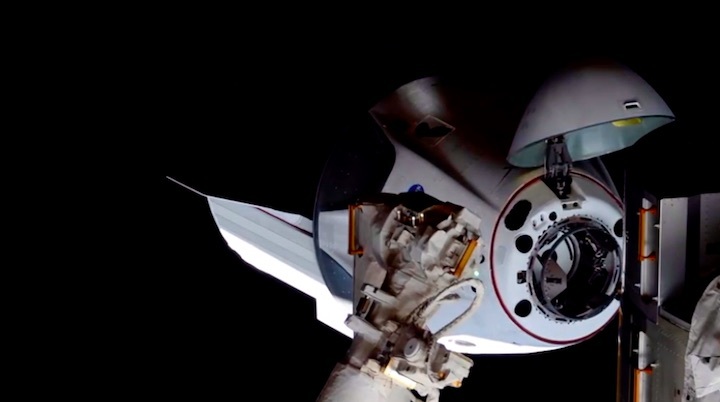2.06.2020

The spacecraft handled just like it did in the simulators back on Earth. The astronauts carefully toggled the controls and signaled the thrusters to gently nudge the capsule around. Outside, fuel escaped in plumes, glittering brightly against the matte black of space before vanishing.
But minutes before the astronauts approached the International Space Station, the commander let go.
The SpaceX capsule they flew in is designed to dock itself autonomously to the space station. Doug Hurley, the spacecraft commander, knew that, when the time came, he would relinquish control to the flight computers. But he’s not quite used to it. He’s a Marine pilot, and the last time he flew to space, he carefully maneuvered the space shuttle toward the ISS on his own, with a steady hand.
“I can promise you that the hardest thing they’ll do tomorrow is, when they’re done flying [manually], is to hand it back over to the computers and not dock it themselves,” Pat Forrester, the chief of NASA’s astronaut office and a former astronaut himself, told me yesterday. “Because they are test pilots … that is exactly what they would enjoy doing.”
But the space shuttles aren’t flying anymore. SpaceX is.
Hurley and his fellow astronaut Bob Behnken reached the ISS this morning, a day after launching from Cape Canaveral in Florida. Their capsule made contact with the space station as both flew over the border of China and Mongolia, about 250 miles above Earth. Capsule and station are now flying as one, cruising at more than 17,000 miles an hour.
Their arrival is part of a historic mission designed not by NASA, but by a private American contractor. Elon Musk’s space company, founded in 2002, is behind the mission from start to finish. Hurley and Behnken, both NASA astronauts, launched in SpaceX suits, atop a SpaceX rocket. When they went to sleep last night, curled into sleeping bags in their seats, the voice they heard from Mission Control didn’t come from Houston, but from Hawthorne, the city in California where SpaceX is headquartered.
NASA hired SpaceX for this job because the agency can no longer launch astronauts on its own. The space shuttles stopped flying in 2011 after three decades of service, more than 100 missions, and two accidents that claimed the lives of 14 astronauts. The program was canceled under President George W. Bush, and wound down under President Barack Obama. With no way to reach space from Cape Canaveral anymore, the United States has paid Russia to ferry its astronauts to and from orbit, a journey that begins in a spaceport in Kazakhstan and costs nearly $90 million a seat. In the meantime, NASA has worked with private companies, including SpaceX, to develop and design an American-made alternative.
With SpaceX in charge of the blueprints, the capsule that arrived at the space station is unlike any vehicle that has visited before. The interiors of the space shuttles were utilitarian and covered with equipment, and the Soyuz, the Russian capsule, is so cramped that astronauts launch with their knees tucked into their chests. The Dragon capsule, by contrast, is roomy, all sleek lines and cushy seats, with a clean black-and-white design reminiscent of Musk’s Teslas. The space shuttle had about 2,000 manual switches and circuit breakers; the SpaceX capsule has about 30. The rest of the controls—the majority of them—exist inside a triptych of touch screens in front of the astronauts’ seats, like oversize iPads.
Hurley and Behnken have said it took some time to get used to the touch-screen controls. A screen doesn’t provide the same physical feedback that signals the completion of an important step or procedure. Last year, well into his preparation for this mission, Behnken told me that he felt like he had to retrain his mind to process his actions on the monitors.
“There’s a mode you can turn on where you can see the touch, so that when you put your finger on the screen, it blooms or it flares—which is extremely helpful when you’re wearing gloves and you might not know if you’ve actually touched it,” Behnken said. “It’s just training yourself to maybe use a different cue, like a visual cue instead of a physical cue, that you’ve actually accomplished the thing that you were trying to do.”
In the shuttle days, commanders always attached the spacecraft to the space station manually. When the shuttle moved within 1,000 feet of the ISS, the commander would look out of the shuttle’s back windows and ease the vehicle toward the station port—not unlike a driver twisting around, putting a hand on the passenger headrest, and taking a peek for any passing cars before backing out. The commander would then gently guide the shuttle in, tail first, with a nail-biting margin of error of about three inches.
